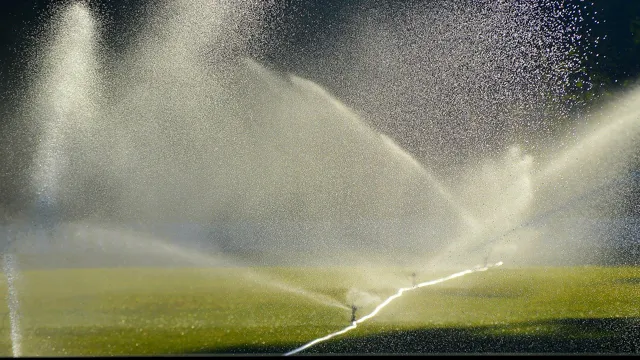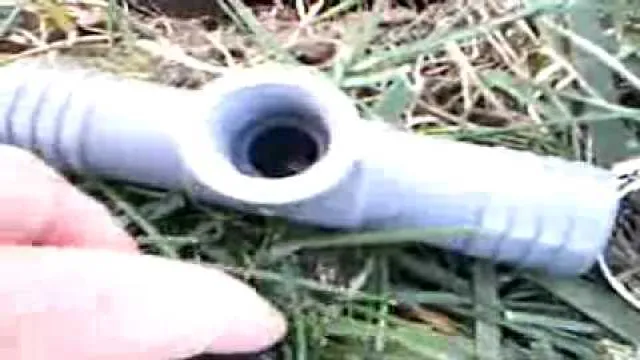Keeping in mind the harsh winter conditions, shutting down your sprinkler system for the season is a crucial step in its upkeep. Neglecting to undertake this task can lead to expensive repairs come springtime. In particular, if you own a Rainbird sprinkler system, it is imperative to learn how to drain it during winter.
This is especially important for those in regions with freezing temperatures, as water left in the system can freeze and cause extensive damage to your irrigation system. In this blog, we’ll walk you through the steps to effectively and efficiently drain your Rainbird sprinkler system.
Why it’s important to drain your sprinkler system for winter
If you’re a homeowner with a sprinkler system, draining it for winter might not be high on your to-do list. However, it’s an essential task that ensures your sprinkler system stays in good condition. In areas with freezing temperatures, leaving water in your sprinkler system can cause damage to pipes, valves, and fittings.
This can lead to costly repairs and replacements when spring arrives. So, it’s crucial to drain your Rainbird sprinkler system properly. Start by shutting off the main water supply and turning off the valves on your backflow preventer.
Then, open up all drain valves and manually drain your system by using compressed air to get out any leftover water. Don’t forget to disconnect and store any watering tools and cover any exposed pipes or valves. Following these steps will keep your sprinkler system from bursting and ensure it’s ready to use again next year.
Avoid Freezing Pipes & Damage
Draining your sprinkler system before winter is crucial to prevent freezing water that can damage your pipes and cause costly repairs. When water freezes, it expands and exerts pressure on the pipes, causing them to crack and burst. This can happen even if the temperature drops just a few degrees below freezing.
By draining your sprinkler system, you remove all the water from the pipes, leaving them dry and free from any chance of freezing. It’s a simple process that should be done every year before the first freeze to ensure your sprinkler system stays in good working order and avoids any unnecessary repairs. So, don’t wait until it’s too late, take the necessary steps to protect your irrigation system and save money in the long run.

Save Money on Repairs
When it comes to caring for your irrigation system, draining it for the winter months is absolutely essential. Failing to do so could result in irreversible damage to your system, leading to costly repairs in the springtime. During the winter months, the water left in your system can freeze and expand, causing pipes to burst and valves to crack.
This kind of damage can easily be avoided by properly draining your system, which involves turning off the main water source, opening all the valves, and using compressed air to remove any excess water. Investing a little time and effort into properly maintaining your irrigation system can save you a lot of money in the long run. So, make sure to add draining your sprinkler system to your winter checklist and avoid any unnecessary expenses next spring!
Extend the Life of your Sprinkler System
As the temperatures begin to drop and winter sets in, it’s crucial to properly maintain your sprinkler system to ensure it lasts for years to come. One important step in this process is draining your sprinkler system before the cold weather hits. While it may seem like an unnecessary hassle, leaving water in the pipes can cause them to burst as the water freezes and expands.
This can lead to costly repairs or even the need to replace the entire system. By taking the time to properly drain the system, you can avoid these issues and extend the life of your sprinkler system. Don’t let neglect lead to a broken system, take the necessary steps to protect your investment and enjoy a lush lawn come springtime.
Steps to drain your Rainbird sprinkler system
Rainbird sprinkler systems are a great addition to any lawn, but in order to keep them working correctly, it’s important to drain them before winter arrives. The process is fairly simple, but it’s important to follow the steps carefully to ensure that all water is removed from the system. First, turn off the water supply to the sprinklers, then turn on each individual zone to release any pressure that may be in the system.
Next, remove the sprinkler heads to allow air to circulate through the system. Once this is done, use an air compressor to blow out any remaining water from the sprinkler lines. Be sure to adjust the air pressure so that it does not exceed the recommended levels for your system.
Finally, put the sprinkler heads back on and cover the controller and any exposed pipes to protect them from the cold weather. By taking these steps, you can ensure that your Rainbird sprinkler system will be ready to use again in the spring.
Turn off the Water Supply to your Sprinkler System
If you live in an area that experiences freezing temperatures during the winter months, it is important to know how to properly drain your Rainbird sprinkler system to avoid damage. The first step is to turn off the water supply to your sprinkler system. This can usually be done through a main shut-off valve or at the backflow prevention device.
Once the water supply is turned off, you will need to drain the water from the system. To do this, start by opening all the drain valves on the sprinkler system. Next, use an air compressor to blow out any remaining water from the pipes and sprinkler heads.
It is important to use the correct pressure, as too much pressure can damage the system. Finally, be sure to remove any water from the backflow preventer and store it in a dry and protected area. By following these steps, you can help prevent costly damage to your sprinkler system during the winter months.
Open the Drain Valves on your Sprinkler System
Draining your Rainbird sprinkler system is an important step in preparing your irrigation system for the winter season. By opening the drain valves, you can ensure that any lingering water in the pipes will be removed, preventing them from freezing and potentially causing costly damage. To begin, turn off the main water supply and locate the drain valves at the low points of your system.
You can then connect a hose to the valve and direct the water away from your property. Allow the valves to remain open until all water has been completely drained from the system. It’s a simple task that can save you a lot of headache in the long run.
Don’t put it off until it’s too late!
Blow out the Remaining Water with an Air Compressor
If you’re looking for a way to protect your Rainbird sprinkler system from winter damage, draining it is a must. One of the key steps in this process is using an air compressor to blow out any remaining water from your system. Doing so can prevent water from freezing and expanding, potentially causing costly damage to your pipes and sprinklers.
To begin, you’ll need to shut off your system’s water supply and find the blowout point. This is typically located near your backflow preventer and will require the use of a special tool to connect your compressor to your system. Once connected, turn on the compressor and gradually increase the air pressure until the water is blown out of your sprinklers or heads.
Repeat this process for each zone in your system until all water has been removed. With these steps, your Rainbird sprinkler system will be well prepared for winter weather, ensuring your lawn and garden will be healthy and hydrated come springtime.
Close Drain Valves & Sprinkler Heads
If you’re based in an area that experiences freezing winters, properly draining your Rainbird sprinkler system is essential to avoid damage caused by freezing water. The first step is to turn off the water supply and activate all zones on the controller to release any remaining water in the pipes. Next, it’s important to close all drain valves and sprinkler heads to prevent water from re-entering the system.
Once all valves are closed, use a compressed air device to blow out any remaining water in the system. It’s crucial that all water has been removed from the system to avoid pipe damage caused by frozen water. By following these steps, you’ll be able to properly drain your sprinkler system and prevent costly repairs in the future.
Conclusion
In conclusion, draining your Rainbird sprinkler system for the winter is essential to prevent damage caused by freezing temperatures. It’s a straightforward process, just like draining a cold beverage on a hot summer day – except in this case, you’re preparing your system for the cold winter ahead. So, don’t let your sprinklers get muddled up when the frosty weather comes knocking.
Take the necessary steps to drain your system, sit back, relax, and admire the beauty of a winter wonderland without any sprinkler concerns.”
Take Action for Your Sprinkler System
If you have a Rainbird sprinkler system, it’s important to take the necessary steps to drain it before winter sets in. This will prevent any water from freezing in the pipes, which can cause them to burst and lead to costly damage in the spring when you turn the system back on. Here are the steps to follow to drain your Rainbird sprinkler system:
Turn off the water supply to the sprinkler system and shut off the controller. Open the drain valves and allow the water to drain from the pipes.
You may need to use a compressor to blow out any remaining water. Remove any attachments or accessories from the sprinkler heads, such as nozzles or filters.
Inspect the system for any damage or leaks that may need to be repaired before winter. Overall, taking the time to properly drain your Rainbird sprinkler system can save you time, money, and headaches in the long run.
So don’t wait until it’s too late, take action now to protect your investment.
FAQs
Why do I need to drain my Rainbird sprinkler system for winter?
Draining your sprinkler system for winter helps prevent damage to pipes and components from freezing temperatures.
When should I drain my Rainbird sprinkler system for winter?
It’s best to drain your sprinkler system before the first freeze of the winter season to prevent any damage.
How can I tell if my Rainbird sprinkler system needs to be drained for the winter?
If you live in an area with cold winter weather, it’s always best to drain your sprinkler system to prevent any damage.
Is draining my Rainbird sprinkler system for winter something I can do myself?
Yes, draining your sprinkler system is something you can do yourself, but it’s important to follow the manufacturer’s instructions carefully or hire a professional to do it for you.
What tools will I need to drain my Rainbird sprinkler system for winter?
You’ll need an air compressor, an air hose with a fitting that matches your sprinkler system’s connection, and a drain valve or drain cap.
Can I just turn off the water supply to my Rainbird sprinkler system instead of draining it for the winter?
No, simply turning off the water supply is not enough to prevent damage from freezing temperatures. You must drain the system to ensure all water is removed from pipes and components.
How often should I drain my Rainbird sprinkler system for winter?
You should drain your sprinkler system every winter before the first freeze to prevent any damage.






